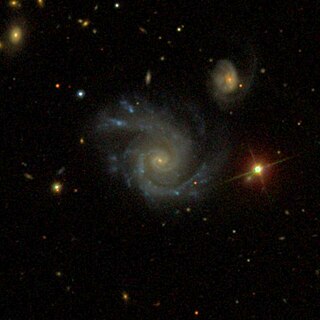
NGC 5829 is a spiral galaxy located in the constellation Boötes. It is 281 million light-years away from Earth and was discovered by astronomer, Edouard Stephan in May 1882.

NGC 67 is an elliptical galaxy located in the constellation Andromeda that was discovered on October 7, 1855, by R. J. Mitchell, who described it as "extremely faint, very small, round". The galaxy belongs to the NGC 68 group, which also contains the galaxies NGC 68, NGC 69, NGC 70, NGC 71, NGC 72, and possibly NGC 74.

LEDA 83677 is a lenticular galaxy located about 290 million light-years away in the constellation Coma Berenices. It is a member of the Coma cluster of galaxies. LEDA 83677 is also classified as a type 1 Seyfert galaxy. The core of the galaxy is emitting high-energy X-rays and ultraviolet light, probably caused by a massive black hole lurking in the core.
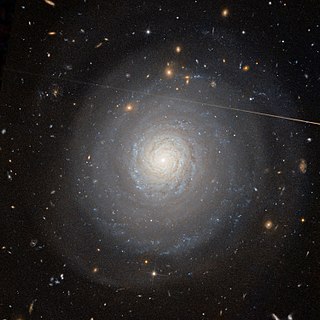
MCG +07-33-027 is an isolated spiral galaxy located about 330 million light-years away in the constellation Hercules. It has a very high rate of star formation which would make it a starburst galaxy. Normally, starburst galaxies are triggered by the collision of another galaxy. However most galaxies are in groups or clusters, while MCG +07-33-027 is solitary. Therefore, the cause of the starburst was not due to a collision or by the passing of a nearby galaxy and so the cause of the activity remains unknown.
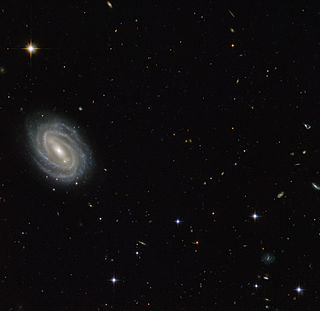
PGC 54493 is a barred spiral galaxy located about 490 million light-years away in the constellation Serpens. It is part of a galaxy group called Abell 2052. It has an estimated diameter of 140,000 light-years.

PGC 44691 is a spiral galaxy located about 350 million light-years away in the constellation Coma Berenices. It belongs to a galaxy cluster known as the Coma Cluster. In 1994, the Hubble Space Telescope observed PGC 44691 and the nearby elliptical galaxy NGC 4881 to infer the distance to the Coma Cluster.
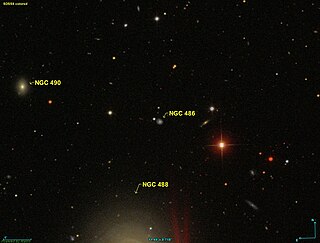
NGC 486, also occasionally referred to as LEDA 1281966 or GC 275, is a spiral galaxy in the constellation Pisces. NGC 486 was discovered on December 6, 1850 by Irish engineer Bindon Blood Stoney.

NGC 502, also occasionally referred to as PGC 5034 or UGC 922, is a lenticular galaxy in the constellation Pisces. It is located approximately 113 million light-years from the Solar System and was discovered on 25 September 1862 by German astronomer Heinrich Louis d'Arrest. When the Morphological Catalogue of Galaxies was published between 1962 and 1974, the identifications of NGC 502 and NGC 505 were reversed. In reality, NGC 502 is equal to MGC +01-04-041 and not MCG +01-04-043 as noted in the catalogue.

NGC 6040 is a spiral galaxy located about 550 million light-years away in the constellation Hercules. NGC 6040 was discovered by astronomer Édouard Stephan on June 27, 1870. NGC 6040 is interacting with the lenticular galaxy PGC 56942. As a result of this interaction, NGC 6040's southern spiral arm has been warped in the direction toward PGC 56942. NGC 6040 and PGC 56942 are both members of the Hercules Cluster.
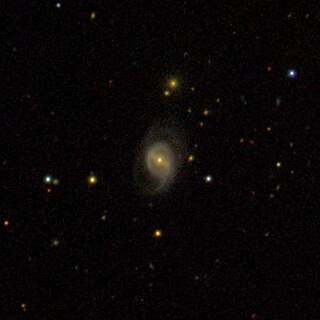
NGC 734 is a lenticular galaxy with a central bar in the constellation Cetus, which is about 538 million light years from the Milky Way. It was discovered on November 9, 1885, by the American astronomer Francis Preserved Leavenworth.

NGC 5910 is an elliptical galaxy located about 540 million light-years away in the constellation Serpens. It was discovered by astronomer William Hershel on April 13, 1785. NGC 5910 is also a strong radio source with a conspicuous nuclear jet.

PGC 65543, is a spiral galaxy, with extensive star forming regions, located in Indus. It is 650 million light-years away from the Solar System and approximately measuring 90,000 light-years in diameter. The tidal interactions from certain galaxies which PGC 65543 is moving towards to, have caused it to get distorted. Its star-forming gas and dust are dynamically stripped by ram-pressure and formed into tendrils that stretch outwards, thus gives an appearance of a jellyfish galaxy.
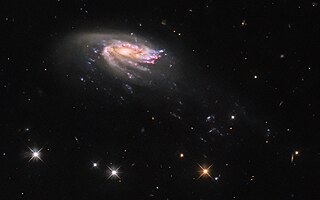
PGC 1228197 known as WINGS J211347.41+022834.9 and JO206, is a large spiral galaxy located 700 million light-years away towards the constellation of Aquarius. The galaxy is estimated to be at least 160,000 light-years in diameter, making it somehow bigger than the Milky Way. With a radial velocity of 15,226 kilometers per second, it is slowly drifting away.

Arp 146 are a pair of interacting galaxies located 1.05 billion light-years away from Earth in the Cetus constellation. It was discovered by Dewhirst and catalogued by Boris Vorontsov-Velyaminov as VV 790. Under the Atlas of Peculiar Galaxies created by Halton Arp, they are categorized under galaxies that have associated rings.

NGC 6331 is a type E elliptical galaxy located in the Ursa Minor constellation. It is located 737 million light-years from the Solar System and was discovered by German-British astronomer William Herschel on December 20, 1797, utilizing an 18.7-inch f/13 spectrum telescope but also observed by Guillaume Bigourdan.

IC 535 known as PGC 26524 and PGC 1128295, is a type E elliptical galaxy with a ring located in the Hydra constellation. It is located 740 million light-years away from the Solar System and has an estimated diameter of 85,000 light-years. IC 535 was discovered on March 23, 1893, by Stephane Javelle. It has a surface brightness of 23.7 mag/arcsec and is moving at radial velocity of 16,049 kilometers per seconds. It is located at right ascension and declination.
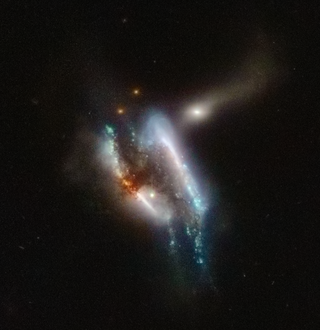
IC 2431 are a group of interacting galaxies in the constellation of Cancer. They are located 684 million light-years away from the Solar System and were discovered on February 24, 1896, by Stephane Javelle.

PGC 1470080 is a type E elliptical galaxy located in the Boötes constellation. It is located 3 billion light-years away from the Solar System and has a diameter of 571,000 light-years, making it a type-cD galaxy and one of the largest.

IC 1166 are a pair of galaxies in the Corona Borealis constellation comprising IC 1166 NED01 and IC 1166 NED02. They are located 977 million light-years from the Solar System and were discovered on July 28, 1892, by Stephane Javelle.
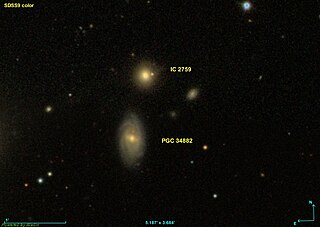
IC 2759 is a small type E elliptical galaxy located in the constellation of Leo. It is located 350 million light-years away from the Solar System and was discovered on April 24, 1897, by Guillaume Bigourdan. Sometimes IC 2759 is confused with the spiral galaxy, PGC 34882 which is located south of the galaxy.




















